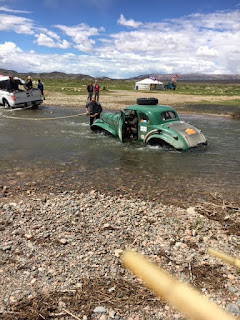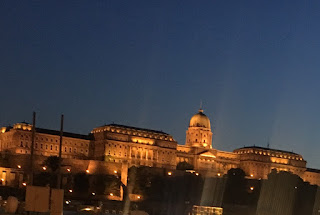The results of the rally are available on the ERA site. 107 cars started and 10 retired. There were two classes Vintageant pre 1941 and Classic 1941 - 1977. There were also - though it doesn't say so on the ERA site two classes of crew. One categorised the difference as between the ardent rallyers and the gentlemen tourers. I'm not sure about the soubriquet 'gentlemen tourers' but you get the general idea: some were there to win and some were there only, or primarily, to arrive in Paris.
The ardent rallyers were remarkably competitive. In the Vintageant category the winner's time was 281 hours 58 minutes and the top 15 cars were within 7 hours of that time. To give you the contrast, there were 42 finishers in the Vintageant category (out of 50 starters) and the
'slowest' time was 456 hours - though slowest is not quite the right term because the times include penalties for time spent broken down. (In fact the whole scoring system was a mystery to us novices - though as you can see, and as we intuited, it scarcely mattered once you'd lost 10 hours or more. In the Classic - 1941-1974 - (57 starters, 55 recorded finishers) the winning time was 260 hours 41 minutes and the next 23 cars were within 10 hours. For a rally timed over some 30 days programmed for driving 8-10 hours each day with up to 6 time trials, it's seriously competitive at the top.
The tourer attitude was very different. There wasn't a need to do every time trial; the ERA route was a starting point but to be compared with the alternative routes - for example those from TomTom or Google Maps. The benefits of early arrival at the next stop were not to be ignored: a balanced view of the attractions of an easier and/or shorter route were considered. And sometimes there were striking differences: Smolensk to Minsk is 3-4 hours on the fast road (allowing for a lunch time arrival and an easy afternoon) whereas the ERA route was 5-6 hours longer. The Tourers arrived in St Moritz in the early afternoon - in time for tea!

The tourers weren't all there by choice. Some, perhaps most, became tourers of necessity when their cars suffered serious damage in Mongolia 'the rolling wounded'. A few, including me, were candidate tourers from the outset: the challenge was survival and enjoyment not victory. No matter: as we progressed, and especially once we reached Europe, the tourers were a sizeable group - 20 crews on some stages and another 15-20 deviating on an ad hoc basis.
And one event crystallised the difference. Car 21, a 1933 Rolls Royce Phantom II suffered a fire in Mongolia and had to return to Ulaan Bataar for rebuilding. Having missed several days, the crew drove 12 hours a day, camping by the road side at night to catch up in Russia. After missing a week or more, they were definitely tourers and as the rally looped north of Moscow they decided on an excursion. They drove into Moscow and persuaded a policeman to let them park for a photo in Red Square.

My reaction was to applaud: what imagination, what ingenuity! But when I said so next evening at dinner, the reaction of my fellow diners was nuanced to say the least. Yes, Hok Kiang Sia had shown initiative but our task was to follow the rally route: we had bought in and we should follow the rules. There was the half articulated threat of club law: if you don't want to play by the rules, you shouldn't be here.
The attitude of the ERA officials was harder: on hearing one of the rolling wounded's enquiry about alternatives to the tough posted route, the official's response was that if a crew wasn't going to follow the tulip directions, the ERA wasn't going to help. And the challenge to tourers was that the sweep teams were dedicated to helping crews following the route not deviators. (In fact the sweep teams were generally pragmatic about helping where the deviation was within 10-15 kms.)
So there's the rub. On the one hand the ERA encourages participants to believe that it will do all it reasonably can to help cars reach Paris. On the other, if your car is damaged that help will be limited. I discussed this with a senior ERA man (a former Clerk of the Course making a guest appearance) who was surprised that a tourer route wasn't available especially in the later stages: he said it had been done before.
The recent history of the Peking to Paris is as an event where fragile older cars comprised the majority of entrants but the trend has been for their numbers to decline. Until 2016, the Vintageant class of pre-1941 cars was in the majority but in 2016, the ardent rallyers in Classic cars comprised over 50%. The trend is clear and I expect the Vintageant numbers to decline further in 2019. But seeing the enthusiasm of spectators for older cars, that will be a loss to all.
















































